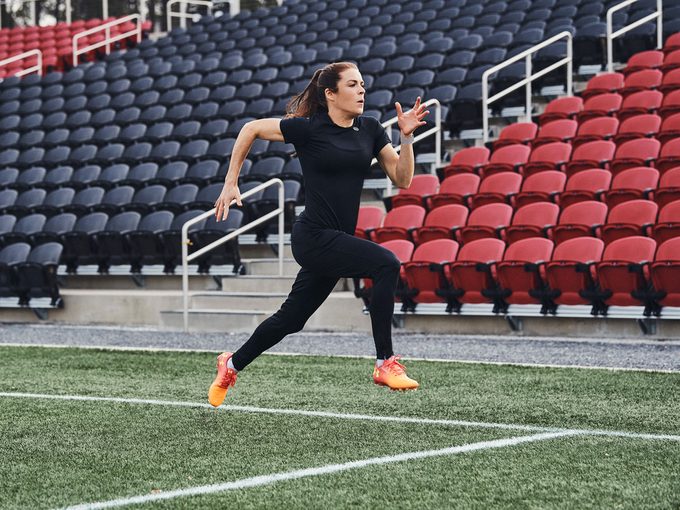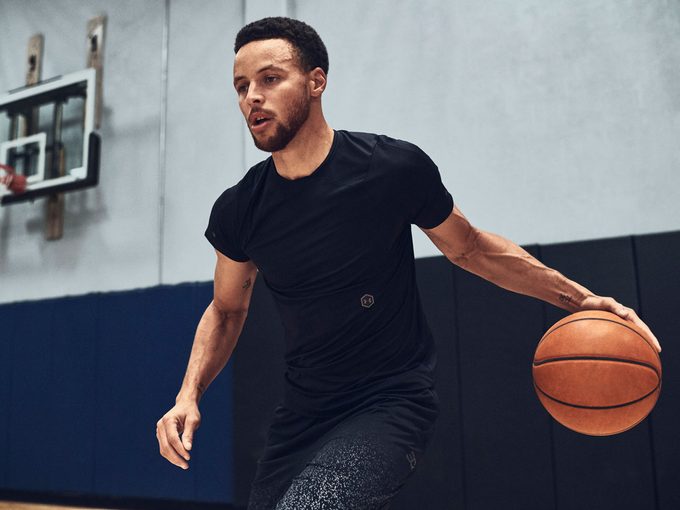5 Ways Elite Athletes Optimize Their Performances (and Their Lives)
How the world’s top athletes get the most out of training and recovery to reach the pinnacles of their careers.

How athletes achieve that next-level performance
An elite athlete’s life is devoted to her sport—whether that’s soccer, basketball, sprinting or boxing—but being a world-class competitor doesn’t just involve soccer drills and shooting practice. Getting to that next level requires a 360-degree approach. “When you work out, on the field or in the gym, that part of your training is where you break down your body,” says Kelley O’Hara, Under Armour athlete, FIFA Women’s World Cup champion and Olympic soccer gold medallist. “If you don’t recover enough, then you’re going to break down more. You can do everything right on the field, but if you’re not taking care of your body off the field, you’re not going to get an upward trajectory. The recovery is where you actually experience your gains.”
Here are five ways that Under Armour athletes, from Kelley O’Hara to Golden State Warriors basketball player Steph Curry, tailor their lives to achieve their physical and mental goals.
#1: They create sleep sanctuaries
Adults require seven to nine hours of quality sleep to reach peak performance—and that means so much more than lying in bed for the appropriate amount of time. Under Armour works with its athletes to create sleep sanctuaries that become an escape from stress, light and heat to ensure the best sleep possible every single night. “We signed Granit Xhaka, one of the best soccer players in the world, and went to his home to filter the air, light, noise,” says Paul Winsper, Under Armour Vice President of Athlete Performance. “We did the same with heavyweight boxer Anthony Joshua.” The team changed the lightbulbs in the athletes’ homes (using the same technology used by astronauts on the International Space Station to enhance sleep and alertness), brought in new mattresses, installed blackout blinds and set up filters to purify the air. “We measured the temperature in Xhaka’s room and it was 29oC, which is like sleeping in a sauna,” says Winsper. “So we gave him a program to go down to about 20oC. You do a couple degrees per night to acclimate over time.” Under Armour also encourages athletes to put their phones away before bed to prepare the brain for sleep. FYI: This is how blue light from your cell phone is messing with your sleep.
#2: They have a routine
The way high performers start their day matters and Paul Winsper says his team works with Under Armour athletes to get a routine in place. “The first thing young athletes do when they wake up? They check their phone,” he says. “But you do that, you’ve lost your day. Somebody has taken your day from you because the first thing you’ve done is check your social media. The first thing you should do is move. Open the curtains. Seek light. Then practice gratitude and make positive affirmations.”
For Kelley O’Hara, stretching before practice is an essential part of her routine. “Every morning, I get to the stadium and have my stretching routine. It’s for my body, but it’s also for focusing my mind. Practice might start at 11am, but I’m there at 8:30 making sure I’m fed and through my whole routine, not rushed. I never did that in the past, but now I’m really focused on the process and I have seen that be successful.”
#3: They work on their minds as much as their bodies
“There are three things as humans that we can train: we can train our craft, we can train our body and we can train our mind,” says high-performance psychologist Dr. Michael Gervais. “And what we’re learning from the best in the world is that they’re not leaving one of those three up to chance.” Kelley O’Hara says that she’s typically very high energy, so she uses meditation to “focus, calm myself down and bring myself back to centre.” For five to 10 minutes before training and games, she puts on a timed meditation with a background soundtrack, “like I’m sitting somewhere in the mountains, and just focus on my breath and feeling how my body feels right there, right then. Thoughts come in and I just acknowledge them and let them go.” The practice of mindfulness meditation increases the frequency that a person can enter flow state, which is “the most optimal state that a human can be in, and it’s also one of the most elusive states,” says Dr. Gervais. “It involves almost a knowing how to adjust to the unfolding, unpredictable, unknown moment. When you can settle into this moment, and course correct and adjust as if you know the answers to the test? That’s flow state.” And that state is essential for anyone working in a field (or on a field!) that requires quick decisions. Just be aware, these meditation mistakes can secretly stress you out.
#4: They’re careful when travelling
No one has time to be sick—high-performing athletes least of all. And because they’re frequently on planes, they have to take precautions against becoming over-tired or infected by viruses or bacteria. “It’s really cool seeing Under Armour athletes travel,” says Paul Winsper. “They’re in these hoodies. They’ve got these blue light–blocking glasses on, because the blue light prevents the release of melatonin. We give them wipes. Airplanes are pretty disgusting, so you’ll see an athlete wiping the tray table, the buckles, the screens. We give them saline solution to stop their nasal passages from dehydrating. Because that’s when the allergens get trapped in.”
#5: They wear workout gear that gives them an edge
All of Under Armour’s athletes—including NBA MVP Steph Currey—now wear the new UA Rush clothing line when training. The collection is made with fabric that’s infused with minerals (a technology created by Celliant that’s also used in Under Armour’s recovery-promoting sleepwear) that basically recycles the body’s energy. “It takes the heat that your body emits and turns it into infrared,” says Paul Winsper. “That then comes back to your body and increases the peripheral blood flow. If you’re increasing blood flow, you’re increasing oxygen in the tissue. The heat that you would have lost becomes an advantage.”

Kelley O’Hara was skeptical of UA Rush at first because she usually trains in baggier clothes. “But once I tried it on and was out on the field performing, it felt right,” she says. “I’m at a place in my career where I’ll take any little thing, so why not bring it into my training regimen? When I first wore it, I said ‘It feels like a nice hug.’ I wear it just knowing that I might get a little bit extra out of my training, which is so important.”
While each of these factors alone may not lead to the perfect performance, every little piece of the puzzle adds up to create athletes who outshine their competitors and reach increasingly greater heights of success. “I just heard this quote the other week,” says O’Hara. “‘Amateurs worry about the outcome and professionals worry about the process.’” And for Under Armour athletes at the top of their game, that day-to-day process is everything—and so much of it happens off the field. Next, learn why this Olympian wants to improve women’s sports in Canada.




